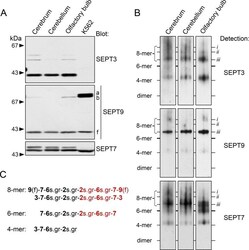Antibody data
- Antibody Data
- Antigen structure
- References [1]
- Comments [0]
- Validations
- Other assay [1]
Submit
Validation data
Reference
Comment
Report error
- Product number
- PA5-31124 - Provider product page

- Provider
- Invitrogen Antibodies
- Product name
- Septin 3 Polyclonal Antibody
- Antibody type
- Polyclonal
- Antigen
- Recombinant protein fragment
- Description
- Recommended positive controls: U87-MG, mouse brain. Predicted reactivity: Mouse (100%), Rat (99%), Zebrafish (87%), Bovine (99%). Store product as a concentrated solution. Centrifuge briefly prior to opening the vial.
- Reactivity
- Human, Mouse
- Host
- Rabbit
- Isotype
- IgG
- Vial size
- 100 µL
- Concentration
- 0.71 mg/mL
- Storage
- Store at 4°C short term. For long term storage, store at -20°C, avoiding freeze/thaw cycles.
Submitted references Cell type-specific expression of SEPT3-homology subgroup members controls the subunit number of heteromeric septin complexes.
Sellin ME, Stenmark S, Gullberg M
Molecular biology of the cell 2014 May;25(10):1594-607
Molecular biology of the cell 2014 May;25(10):1594-607
No comments: Submit comment
Supportive validation
- Submitted by
- Invitrogen Antibodies (provider)
- Main image

- Experimental details
- FIGURE 7: Septin expression and the subunit number of heteromers in brain tissues. (A) SEPT3, SEPT9, and SEPT7 expression in the indicated parts of mouse brain was analyzed by SDS-PAGE and Western blotting (loaded at 5 mug/lane). As a reference, the analysis also included the human cell line K562 (loaded at 20 mug/lane). Right, positions of isoforms a, b, and f. (B) Septin heteromers as resolved by blue native PAGE, followed by detection of SEPT9 (top) and SEPT7 (bottom). Septin complexes are annotated according to Figure 5 . (C) Septin heteromers in brain-derived tissues are depicted according to premises stated in Figure 3G . Atypical tetramers, which are depicted to be arranged according to homology subgroup membership, contain mainly a single SEPT3 subgroup member, namely SEPT3. Note that only the olfactory bulb contains detectable amounts of hexamers. The data are representative of three independent analyses.
 Explore
Explore Validate
Validate Learn
Learn Western blot
Western blot Other assay
Other assay